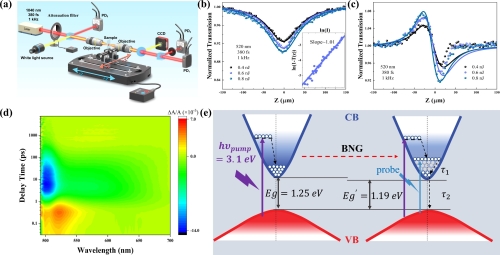Recently, researchers in Shanghai Institute of Optics and Fine Mechanics (SIOM) of the Chinese Academy of Sciences (CAS), carried out systematic investigation on the microscopic optical nonlinearities and transient carrier dynamics in Indium Selenide (InSe) Nanosheet. The related research results have been published in Optics Express on May 9, 2022.
In recent decades, two-dimensional (2D) materials have attracted great attention and been widely used in many fields. It is fundamental but significant to study the intrinsic characteristics and further realize the controllable modification engineering of these optical and physical properties in 2D materials. InSe, an excellent optoelectronic material, has been studied in nonlinear optic, optoelectronic, biomedicine, and other fields. However, its intrinsic nonlinear optical properties have not been carefully studied.
In this work, the researchers prepared a series of InSe nanosheets with different thicknesses through the mechanical exfoliation method, and systematically investigated the nonlinear optical properties and broad-spectrum ultrafast carrier dynamics. The nonlinear optical properties were measured through home-bulit micro-Z/I-scan setup under the excitation of 520 nm and 1040 nm fs pulses. InSe films exhibit two-photon absorption (TPA) effects under both the visible and near-infrared light excitation, and the InSe nanosheets are more likely to achieve TPA saturation in the visible range as the TPA coefficient of InSe of same thickness excited by 520 nm is two orders of magnitude larger than that excited by 1040 nm, and Is,520 nm is one order of magnitude smaller than Is,1040 nm. Transient absorption spectroscopy measurements showed that InSe films have an ultrafast transition from photo-induced absorption to photobleaching and a fast relaxation process of ~0.4-1 ps in the visible range.
The systematic study of the intrinsic nonlinear optical properties of InSe nanosheets and ultrafast carrier dynamics provides experimental and theoretical guidance for the development of InSe based optoelectronic devices as well as inspiration for nonlinear optical testing of other two-dimensional materi als.

Figure 1. (a) Schematic of the μ-Z/I-scan setup used for the NLO experiment. (b-c) The open/closed-aperture μ-Z-scan results of InSe film. (d) Transient absorption spectrum of InSe flake under a 200 fs-pulsed laser excitation at 400 nm. (e) Schematic diagram of the carrier relaxation process. (Image by SIOM)
Article website:
https://doi.org/10.1364/OE.459023
Contact:
WU Xiufeng
General Administrative Office
Shanghai Institute of Optics and Fine Mechanics, CAS
Email: xfwu@siom.ac.cn
Web: http://english.siom.cas.cn/